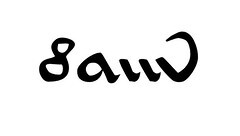Voynich Reconsidered: the {8am} strategy revisited
In my new book Voynich Reconsidered (Schiffer Books, August 2024), one of my objectives was to engage the reader in a quest for the underlying meaning of the inscrutable Voynich manuscript; and to provide him or her with the tools to do so.
In an earlier article on this platform, I set out my idea of an efficient strategy for identifying the presumed precursor languages of the Voynich manuscript. The strategy is based on testing whether any given transliteration of the manuscript, and any potential precursor language, together yield a mapping from Voynich “words” to real words. I proposed to focus on the v101 “word” {8am}, the most common “word” in the manuscript. For that reason, I called this approach the {8am} strategy.
My subsequent work on what I call “leaf words” has instilled a doubt in my mind as to whether {8am} is a “word” at all. I found some evidence that {8am} might be an arbitrary, and possibly meaningless, filler for gaps between intervening illustrations, like the plants in the “herbal” section. However, {8am} occurs hundreds of times outside the “herbal” section, and in locations which are not adjacent to illustrations. I thought it worthwhile, therefore, to persevere with the {8am} strategy.

The Voynich “word” {8am}, rendered in the Voynich v101 font. Image credit: Rebecca G Bettencourt / KreativeKorp.
The {8am} strategy is, in essence, to try multiple transliterations of the Voynich manuscript, in permutations with multiple precursor languages; for each permutation, to map {8am} to a text string in the target language; and to search a suitable corpus of the target language for that string as a real word.
My transliterations, all derived from v101, are currently numbered from v101④ to v226. Some of my transliterations allow for {8am} to be not three glyphs, as it is in v101; but four glyphs, which I write as [8aîń], or five, which I write as [8aiiń].
Following Mary D’Imperio and Massimiliano Zattera, I allowed for the possibility of re-ordering the letters in the text string: even of reversing the order, to allow for target languages which are written from right to left (as is the case with Arabic, Hebrew, Persian and Ottoman Turkish)
In cases where {8am} could be mapped to a real word, it might be a common word, or a rare word. It seemed to me that, the more common the word, the more encouragement we might feel for our permutation of transliteration and language.
The first mappings
As reported earlier: in my first implementation of the {8am} strategy, I started with three potential precursor languages and four corpora, as follows:
The most encouraging result came from the mappings to medieval Italian using the letter frequencies in the OVI corpus. Allowing for re-ordering or reversing the text string, it seemed possible to map {8am} to either of the following words:
In the next stage of mapping, I tested the following potential precursor languages:
Selected mappings of the "word" [8am} to words in some medieval European languages. Author's analysis. Higher resolution at https://flic.kr/p/2q4ow8z
In each case, there were multiple transliterations which yielded the same mapping. I was inclined to prioritise the transliterations according to what I call the AFD metric (the average absolute frequency difference), as outlined in previous articles on this platform. What I identified as the “best transliteration” is not necessarily the right one. To narrow down the choices will require mapping of other Voynich “words”.
Next steps
The next step would be to map some other ubiquitous “words” in the Voynich manuscript. To avoid possible “filler words”, I am inclined to look at “words” of at least three glyphs, such as {1oe}, {2oe} and {1oy}. Again, the objective would be to map these “words” to text strings in selected target languages, and to see whether those strings are real words. If we can map several common Voynich “words” to real words in some medieval languages, we might continue towards mappings of whole lines. We will be looking for such mappings to make grammatical sense.
In an earlier article on this platform, I set out my idea of an efficient strategy for identifying the presumed precursor languages of the Voynich manuscript. The strategy is based on testing whether any given transliteration of the manuscript, and any potential precursor language, together yield a mapping from Voynich “words” to real words. I proposed to focus on the v101 “word” {8am}, the most common “word” in the manuscript. For that reason, I called this approach the {8am} strategy.
My subsequent work on what I call “leaf words” has instilled a doubt in my mind as to whether {8am} is a “word” at all. I found some evidence that {8am} might be an arbitrary, and possibly meaningless, filler for gaps between intervening illustrations, like the plants in the “herbal” section. However, {8am} occurs hundreds of times outside the “herbal” section, and in locations which are not adjacent to illustrations. I thought it worthwhile, therefore, to persevere with the {8am} strategy.

The Voynich “word” {8am}, rendered in the Voynich v101 font. Image credit: Rebecca G Bettencourt / KreativeKorp.
The {8am} strategy is, in essence, to try multiple transliterations of the Voynich manuscript, in permutations with multiple precursor languages; for each permutation, to map {8am} to a text string in the target language; and to search a suitable corpus of the target language for that string as a real word.
My transliterations, all derived from v101, are currently numbered from v101④ to v226. Some of my transliterations allow for {8am} to be not three glyphs, as it is in v101; but four glyphs, which I write as [8aîń], or five, which I write as [8aiiń].
Following Mary D’Imperio and Massimiliano Zattera, I allowed for the possibility of re-ordering the letters in the text string: even of reversing the order, to allow for target languages which are written from right to left (as is the case with Arabic, Hebrew, Persian and Ottoman Turkish)
In cases where {8am} could be mapped to a real word, it might be a common word, or a rare word. It seemed to me that, the more common the word, the more encouragement we might feel for our permutation of transliteration and language.
The first mappings
As reported earlier: in my first implementation of the {8am} strategy, I started with three potential precursor languages and four corpora, as follows:
• Finnish as written around 1548, represented by Uusi Testamentti (The New Testament)and with thirty-seven alternative transliterations of the Voynich manuscript, which I had numbered from v101④ to v202.
• Early New High German as written around 1401, represented by von Tepl's Der Ackerman aus Böhmen (The Ploughman from Bohemia)
• vernacular Italian (perhaps I should say Tuscan-Italian) as written around 1308-21, represented by Dante's La Divina Commedia (The Divine Comedy)
• Italian as written prior to 1400, represented by the OVI corpus, or Opera del Vocabolario Italiano,
The most encouraging result came from the mappings to medieval Italian using the letter frequencies in the OVI corpus. Allowing for re-ordering or reversing the text string, it seemed possible to map {8am} to either of the following words:
• “con”, which occurs 135,186 times in OVI and translates to English as “with”The second stage of mapping
• “dio”, which occurs 55,550 times in OVI and translates to English as “God”.
In the next stage of mapping, I tested the following potential precursor languages:
• Albanian as written in 1555, as represented by Gjon Buzuku’s Meshari (Missals)To cut to the chase: in addition to the previously identified mappings to medieval Italian, these tests yielded just two languages in which {8am} could be mapped to real words:
• Arabic as written in the fourteenth century, represented mainly by Ibn Kathir’s البداية والنهاية (The Beginning and the End), by courtesy of Dr Mohsen Madi
• Arabic as written in the eighth through fifteenth centuries, represented by three corpora: Grammarians, Medieval Philosophy and Science, and The Thousand and One Nights, by courtesy of Dr Dilworth Parkinson
• Bohemian as written prior to 1314, represented by Dalimilova Kronika (The Chronicles of Dalimil)
• English as written in the 1330s, represented by the Auchinleck manuscript, lines 1 to 2330
• English as written between 1488 and 1500, represented by the Ashmole 61 manuscript, parts 1 to 27
• French as written around 1440, represented by La Farce de Maistre Pathelin
• Galician-Portuguese as written between 1220 and 1300, represented by Cantigas d'Amigo (Songs of a Friend)
• Latin as written in the seventh through fourteenth centuries, represented by the LatinISE medieval subcorpus, by courtesy of Barbara McGillivray
• Latin as written in 1312-13, represented by Dante’s Monarchia
• Persian, represented by a predominantly medieval corpus of the works of forty-eight poets, by courtesy of https://github.com/amnghd/Persian_poe...
• Ottoman Turkish as written prior to 1631, represented by Ismail Ankaravi’s كتاب منهاج الفقراء Kitabi Minhac ul-Fukara
• Welsh as written in the mid-fourteenth century, represented by The White Book of Mabinogion.
* Arabic as written in the fourteenth century: the words منع (“prevention” or “it prevents”), أمي (“my mother” or “maternal”), أيم (“widow” or “widowed”)
* English as written in the 1330s: the word “and”.

Selected mappings of the "word" [8am} to words in some medieval European languages. Author's analysis. Higher resolution at https://flic.kr/p/2q4ow8z
In each case, there were multiple transliterations which yielded the same mapping. I was inclined to prioritise the transliterations according to what I call the AFD metric (the average absolute frequency difference), as outlined in previous articles on this platform. What I identified as the “best transliteration” is not necessarily the right one. To narrow down the choices will require mapping of other Voynich “words”.
Next steps
The next step would be to map some other ubiquitous “words” in the Voynich manuscript. To avoid possible “filler words”, I am inclined to look at “words” of at least three glyphs, such as {1oe}, {2oe} and {1oy}. Again, the objective would be to map these “words” to text strings in selected target languages, and to see whether those strings are real words. If we can map several common Voynich “words” to real words in some medieval languages, we might continue towards mappings of whole lines. We will be looking for such mappings to make grammatical sense.
No comments have been added yet.
Great 20th century mysteries
In this platform on GoodReads/Amazon, I am assembling some of the backstories to my research for D. B. Cooper and Flight 305 (Schiffer Books, 2021), Mallory, Irvine, Everest: The Last Step But One (Pe
In this platform on GoodReads/Amazon, I am assembling some of the backstories to my research for D. B. Cooper and Flight 305 (Schiffer Books, 2021), Mallory, Irvine, Everest: The Last Step But One (Pen And Sword Books, April 2024), Voynich Reconsidered (Schiffer Books, August 2024), and D. B. Cooper and Flight 305 Revisited (Schiffer Books, coming in 2026),
These articles are also an expression of my gratitude to Schiffer and to Pen And Sword, for their investment in the design and production of these books.
Every word on this blog is written by me. Nothing is generated by so-called "artificial intelligence": which is certainly artificial but is not intelligence. ...more
These articles are also an expression of my gratitude to Schiffer and to Pen And Sword, for their investment in the design and production of these books.
Every word on this blog is written by me. Nothing is generated by so-called "artificial intelligence": which is certainly artificial but is not intelligence. ...more
- Robert H. Edwards's profile
- 68 followers



